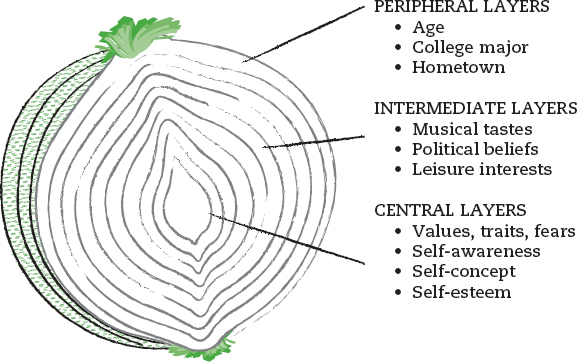Opening Your Self to Others
In the movie Shrek, the ogre Shrek forges a friendship with a likable but occasionally irksome donkey (Adamson & Jenson, 2001). As their acquaintance deepens to friendship, Shrek tries to explain the nature of his inner self to his companion: “For your information, there’s a lot more to ogres than people think! . . . Ogres . . . are like onions. . . . Onions have layers—OGRES have layers! Onions have layers! You get it!? We both have layers!”
Shrek was not the first to use the onion as a metaphor for self. In fact, the idea that revealing the self to others involves peeling back or penetrating layers was first suggested by psychologists Irwin Altman and Dalmas Taylor (1973) in their social penetration theory. Like Shrek, Altman and Taylor envisioned the self as an “onion-skin structure,” consisting of sets of layers.4

At the outermost, peripheral layers of your self are demographic characteristics such as birthplace, age, gender, and ethnicity (see Figure 2.2). Discussion of these characteristics dominates first conversations with new acquaintances: “What’s your name? Where are you from?” In the intermediate layers reside your attitudes and opinions about music, politics, food, entertainment, and other such matters. Deep within the “onion” are the central layers of your self—core characteristics such as self-awareness, self-concept, self-esteem, personal values, fears, and distinctive personality traits. We’ll discuss these in more detail in Chapter 3.
The notion of layers of self helps explain the development of interpersonal relationships, as well as how we distinguish between casual and close involvements. As relationships progress, partners communicate increasingly personal information to each other. This allows them to mutually penetrate one another’s peripheral, then intermediate, and finally central selves. Relationship development, therefore, is like slowly pushing a pin into an onion: it proceeds layer by layer, without skipping layers.
The revealing of selves that occurs during relationship development involves both breadth and depth. Breadth is the number of different aspects of self each partner reveals at each layer—the insertion of more and more pins into the onion, so to speak. Depth involves how deeply into the other’s self the partners have penetrated: have you revealed only your peripheral self, or have you given the other person access into your intermediate or central selves as well?

The ability to share our selves with someone else feels like a rare experience, but when the opportunity arises, information flows more freely, and greater relational intimacy develops.
Cathy Yeulet/123RF.com
Although social penetration occurs in all relationships, the rate at which it occurs isn’t consistent. For example, some people let others in quickly, while others never grant access to certain elements of their selves, no matter how long they know a person. The speed with which people grant one another access to the broader and deeper aspects of their selves depends on a variety of factors, including the attachment styles discussed earlier in the chapter. But, in all relationships, depth and breadth of social penetration is intertwined with intimacy: the feeling of closeness and “union” that exists between us and our partners (Mashek & Aron, 2004). The deeper and broader we penetrate into each other’s selves, the more intimacy we feel; the more intimacy we feel, the more we allow each other access to broad and deep aspects of our selves (Shelton, Trail, West, & Bergsieker, 2010).
4Although Altman and Taylor use personality to describe the self, they define personality in terms of self-concept and self-esteem, and use the terms personality and self interchangeably throughout their text (for example, see 1973, pp. 17–19).